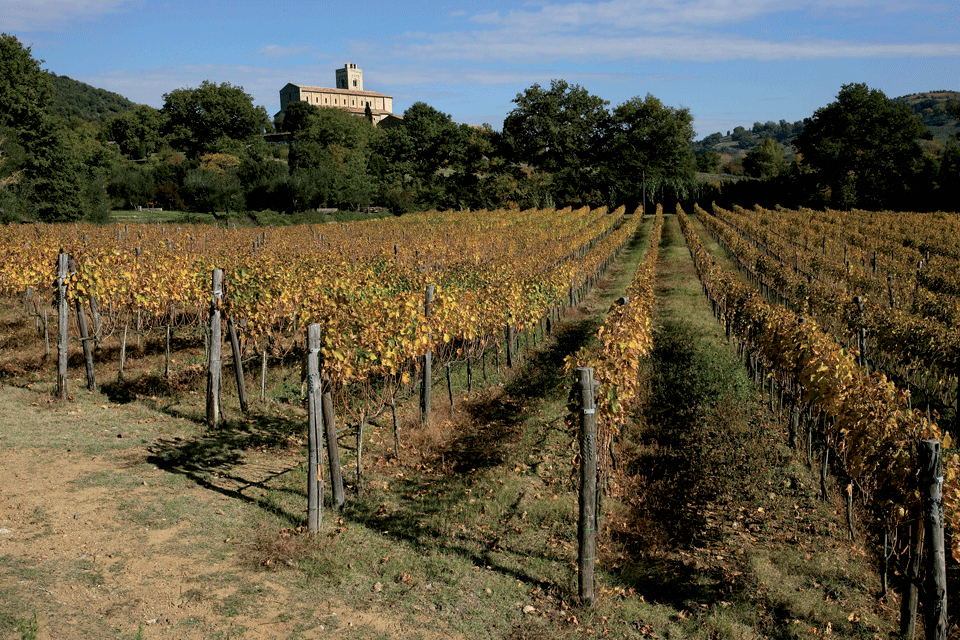Description
The Sant’Antimo PDO is reserved for the following types of wine: White, Red, Vin Santo, Vin Santo Occhio di Pernice and Novello. The Designation also incorporates numerous grape variety specifications.
Production Area
The production area of Sant’Antimo PDO is within parts of the territory of the municipality of Montalcino in the Province of Siena, in the Tuscany region.
Description of product typologies
Sant’Antimo PDO Bianco is straw-yellow, at times with greenish reflections; the nose displays a range of floral notes of yellow flowers and fruity notes, with traces of grass and spiciness; it is sapid on the palate, with an acidity that blends harmoniously with the rich structure and a persistent finish. Sant’Antimo PDO Rosso is intense ruby red, tending towards garnet red with ageing; the nose is rich with ripe fruit, evolving into sensations of spices and leather; it is well-structured and full-bodied on the palate, with the flavours evolving into liquorice, chocolate and earth, highlighting embracing tannins and a pleasantly persistent finish. Sant’Antimo PDO Vin Santo displays a chromatic range that varies from pale golden to intense amber; the nose is decisive, with notes of honey and pastries and undertones of dried fruit; the palate offers velvety sensations with a smooth attack, thereby giving the impression of harmony and elegance in the long, persistent finish. It can display Riserva on the label. Sant’Antimo PDO Vin Santo Occhio di Pernice is various shades of pink; the nose reveals a significant fruity and floral bouquet, with notes of dried fruit; it is smooth, structured and embracing on the palate, with an extremely long finish. Sant’Antimo PDO Novello is ruby red with evident purplish reflections; the nose is vinous and reminiscent of freshly pressed grapes and red berries; it is sapid, lively and harmonious on the palate. Sant’Antimo PDO Vin Santo and Sant’Antimo PDO Vin Santo Occhio di Pernice wines must be produced with traditional vinification methods which involve the carefully selected grapes being dried naturally in suitable environments; the grapes can be partially dried with the aid of ventilated air. The grapes can be mashed between December 1st of the harvest year and March 31st of the following year. Storage and ageing must take place in wooden kegs with a maximum capacity of 5 hectolitres; Sant’Antimo PDO Vin Santo and Sant’Antimo PDO Vin Santo Occhio di Pernice wines cannot be released for consumption before November 1st of the third year following that in which the grapes were produced. For Riserva wines the date is November 1st of the fourth year following that in which the grapes were produced.
Geographical and sub-area specifications
The Sant’Antimo PDO can also be accompanied by additional geographical and toponymical specifications referring to municipalities, areas, farms and localities within the production area and from where the grapes used to produce the wine effectively originate.
Grape variety specifications
The Sant’Antimo PDO may display the following grape variety specifications. From white grape varieties: min. 85% Chardonnay, Sauvignon, Pinot Grigio, pure or with the addition of similarly-coloured grapes originating from other grape varieties suitable for cultivation in the concerned area, max. 15%. From red grape varieties: min. 85% Cabernet Sauvignon, Merlot, Pinot Nero, pure or with the addition of similarly-coloured grapes originating from other grape varieties suitable for cultivation in the concerned area, max. 15%. The characteristics of the colour, fragrances and flavour of each specification are those typical of the grape variety and terroir of origin.








